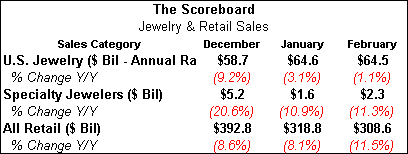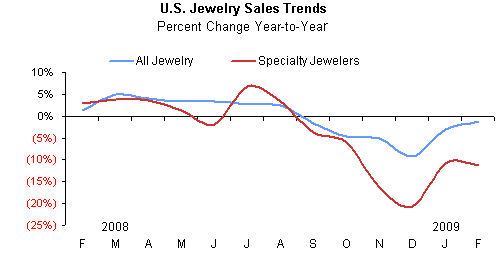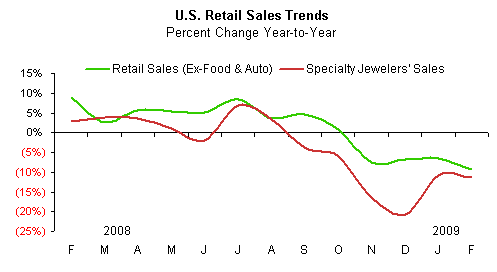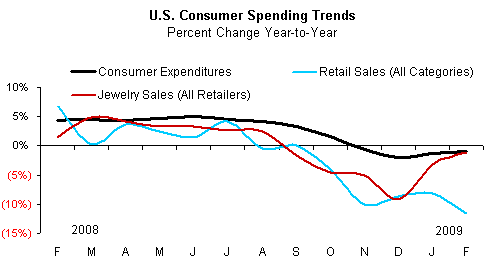IDEX Online Research: U.S. Jewelry Demand Stabilizes
April 23, 09
After dipping deeply in November and December, demand for jewelry – and other retail goods – has shown signs of stabilizing in the U.S. market. While retail sales this year are still down from the first two months of 2008, the decline is much more moderate than the rate of decrease at the end of last year.
From a broad perspective, retail and jewelry sales for the first two months of 2009 – all retail categories, all retail categories less autos and food, and specialty jewelers’ sales – are running roughly 90 percent – more or less – of last year’s levels for the same two-month period. In short, it is not the end of the world for consumer spending (though the mass media would have us believe that the end is near). Shoppers are still spending, but their rate of spending is down by about 10 percent or so on a year-to-year basis.
Specialty jewelers’ sales in the U.S. market in February were $2.3 billion, down just over 11 percent. Retail sales – all categories including autos and food – of $308.6 billion were down about 11.5 percent in February.
Total U.S. consumer spending on jewelry in February was running at an annual rate of $64.5 billion (preliminary figures), down just over 1 percent from the prior year. Obviously, this very modest decline is in striking contrast to retail sales trends (which are down about 10 percent), but we think this number will be revised downward in the next few months. The Department of Commerce has been making substantial corrections to this data set for the past few months, and we look for further revisions.
The table below summarizes retail sales and consumer spending trends for total jewelry, specialty jewelers and all retailers for the past three months.

Source: U.S. Dept. of Commerce
Jewelry Demand Steady
For the past two months, jewelry demand in the U.S. has been fairly steady, both at specialty jewelers as well for the aggregate industry.
- Total jewelry sales – retail sales of jewelry at all stores, including discounters, specialty stores, and all outlets – has been running at 97-99 percent of prior year levels. We caution that these are preliminary numbers, and we believe that it will be revised downward. However, the trend is clear: demand has more or less stabilized.
- For specialty jewelers, the trend is the same: sales have stabilized. After falling dramatically – with a decline near 20 percent – during the all-important holiday selling season, sales at specialty jewelers have stabilized at around a 10 percent decline in January and February.
It is no surprise that specialty jewelers are posting much more disappointing results than the industry as a whole. Historically, specialty jewelers lose market share in recessionary periods. Unfortunately, they never seem to regain that market share.
Why do specialty jewelers lose market share? Time and time again, we hear the old refrain from shoppers: “We can’t afford to pay the prices that specialty jewelers charge. We shop at discounters.” What those consumers don’t understand is this: 1) the prices at most discounters and specialty stores are very similar for similar goods (though much of the merchandise at discounters is often lower quality which means that overall price points are lower, creating the perception of “a deal”); and 2) they would probably get a much better value at specialty jewelers. The problem, of course, is getting this message to shoppers, and then getting them to understand and believe it.
The graph below contrasts specialty jewelers’ sales trends with total jewelry sales trends for the past year.

Source: U.S. Dept. of Commerce
Jewelers Lose Market Share to Other Retail Categories
Recently revised figures from the Department of Commerce show that jewelry sales have been weaker than overall retail sales since September 2008.
In February 2009, specialty jewelers’ sales were down 11.3 percent, while total retail sales, ex-auto and food, were down a more moderate 9.3 percent. If auto and food categories are included, retail sales were down 11.5 percent in February. We eliminate auto and food categories because they can distort overall consumer demand trends. Auto sales are driven by the “deal of the day” promotion, while food demand is not discretionary.
The graph below summarizes sales trends for all retail goods (green line) excluding food and automobiles versus specialty jewelers’ sales (red line).

Source: U.S. Dept. of Commerce
Consumer Spending Showed A Very Modest Recovery in February
As inflation has dissipated over the past few months, growth of consumer expenditures has also slowed from 2008. In December, consumer spending was 2.0 percent below the prior year. However, in January, preliminary figures show that consumer spending dipped by a revised 1.3 percent from January 2008. In February, very preliminary data shows that total consumer spending was down only 1.0 percent - said another way, it has been running at roughly 99 percent of last year’s levels. This is another hopeful sign, but it is too early in the year to read anything into it, in our opinion.
What is behind slower consumer expenditure growth? As the graph below shows, total retail sales growth took a dive in the early fall. Spending on big-ticket durables – often financed on credit – suffered the most. Consumer expenditures on services also slowed modestly.
The graph below summarizes trends in American’s total spending (black line), retail sales of all goods (blue line) and expenditures on jewelry (red line). It is clear that dismal automobile sales in the U.S. market are having a dramatic negative impact on total retail sales (blue line). Automobile sales in 2007 were just over 20 percent of total retail sales; thus, it is clear why they have such an impact on total retail sales trends. And, it should be obvious why we typically eliminate them, when we analyze U.S. retail sales. Automobile sales are driven largely by the “deal-of-the-day,” as we noted above.

Source: U.S. Dept. of Commerce
Our Forecast: Tentative, But As Fearless As Ever
We try to be realistic, but, frankly, we are an optimist at heart. In the U.S., there are signs – tentative, but still signs – that indicate the recession is certainly not worsening, and may be abating.
The U.S. regulators and government attacked the economic weakness early and head-on. In our opinion, government intervention was needed to keep this recession from becoming a full-blown depression. Warren Buffett, chairman of Berkshire Hathaway, said it best in his annual letter to shareholders: “By the fourth quarter [of 2008], the credit crisis, coupled with tumbling home and stock prices, had produced a paralyzing fear that engulfed the country. A freefall in business activity ensued, accelerating at a pace that I have never before witnessed. This debilitating spiral spurred our government to take massive action. Whatever the downside may be, strong and immediate action by government was essential last year, if the financial system was to avoid a total breakdown.”
Because of massive government action, the U.S. market will apparently avoid a depression. We can’t speak for other regions of the world, especially where politicians are deadlocked in debate while their constituents suffer. This much we know: 1) the U.S. economy is more resilient than most people understand (the media has no clue about this fact); and, 2) we’d never bet against the Fed (the entity that has been most instrumental in dosing the economy with medicine). We use these theses (1 and 2 above) to say this to diamantaires: those of you who gave up early on the U.S. market in search of sales in other regions of the world may have made a terrible mistake.
Our preliminary forecast calls for U.S. jewelry sales in 2009 to be between about $58 billion and $61 billion, a decline of about 7 percent to about 12 percent from 2008.
A sales decline of the magnitude that we are forecasting is not disastrous for retailers. Most merchants have been able to cut costs to reflect the reduced revenue stream. However, a 10 percent sales decline (with a range of a 7 percent to 12 percent decrease) could be a disaster for some suppliers. Retail jewelers typically have a year’s worth of goods in inventory, so they don’t need to re-order merchandise when it is sold. Thus, while retailers’ revenue stream has slowed, suppliers’ revenue streams have dried up to barely a trickle, if that, in the current environment.
In the Great Depression, jewelry sales fell by about 70 percent from peak to valley over a multi-year period, and it took about eight years for jewelry sales to recover to pre-Depression levels. This scenario will not repeat itself.